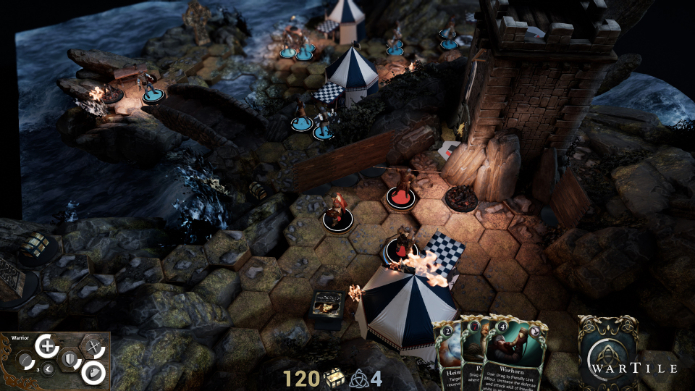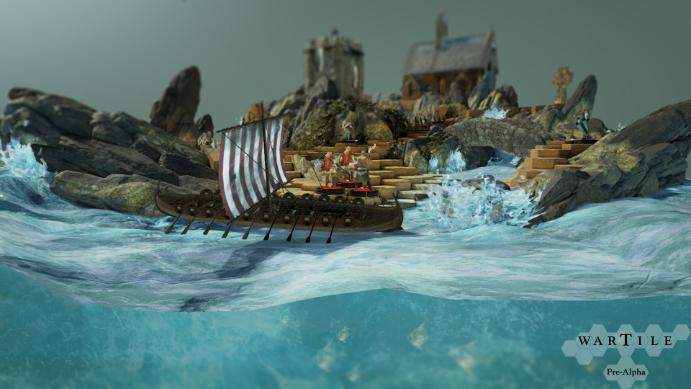Launching back in March as part of Steam’s Early Access programme, Wartile, the latest title from developers Playwood Project, is a strategy-focussed title heavily inspired by popular tabletop board games. Setting all the action within stylish dioramas set upon hex panels, the game immediately captures interesting visual design that, while lacking in polish, separates this game from its competition, resulting in a game that’s made all the more interesting to play. Though, at present, the game feels far from perfect, it stands as a prime example of a title that keeps improving upon itself with each and every content update. With developers such as this that are clearly committed to the project, one thing is certain: Wartile shows a wealth of promise despite its in-development status.

Beginning life as a fairly barebones affair that felt like little more than a conceptual demo, Wartile has since grown significantly in content, scope, and in its technical boundaries. Though only a few months down the line and still sitting well within the realms of an Alpha state, the continued efforts made by its developers to add more substance has ultimately lead to a bigger and better game. Seeing plenty of content additions in its most recent June update, as well as important gameplay tweaks and improvements in areas that needed addressing, the Wartile of June 2017 stands as a vastly improved product over its previous iterations.

Taking a trip into Norse mythology and placing you at the helm of a group of Viking troops, Wartile places a substantial focus on building your army as well as deploying them. Taking its board game inspiration quite literally, each soldier takes the form of a detailed figurine that can be customised to better suit specific play styles and tactical approaches. Levelling up the more each figure is used; figure-specific abilities are unlocked over time and can be equipped at will, with each one bringing something thoughtful to the table. Not stopping there, individual stats such as attack, defence, health and accuracy can also be boosted through the use of tokens, and weapons/armour can also be swapped out for better gear found readily available on the battlefield. All of this spread evenly across the game’s four current character classes: Warrior, Spearman, Brute and Archer, and there’s a surprising level of freedom to how you can approach each battle scenario.

Fitting the mould of a real-time strategy title rather than that of a turn-based, Wartile’s approach to its gameplay isn’t what you might expect, especially given its board game roots. Sitting oddly within the strategy space, it initially takes a while to adjust to the general gameplay flow and, while its methods more than allow for fun and somewhat-effective tactical deployment, it’s hard to escape from just how messy and imprecise it can feel at times. Though movement and combat are bound within cooldown constraints, ultimately everything else runs in real-time, with each moment transitioning straight into the next without pause or warning. As a result, this makes the game feel harder to manage than it should, leading to some scenarios that feel chaotic and overly difficult to manage. Despite the option to slow down time to better co-ordinate your moves, assess the on-screen action and give yourself a breather, it doesn’t feel like the best option since constantly shifting between gameplay speeds feels jarring at best.

Wartile’s identity unfortunately allows for weaker tactical opportunity overall – in its current unfinished state, at least – and if you aren’t quick enough to read situations, adapt and make the correct move it can have a detrimental impact on your team’s effectiveness. Feeling like a more accessible strategy title than most given its more simplistic mechanical design, by no means is this totally game-breaking – this isn’t X-Com, after all – but it can be hard to feel as though you’re in real control of the battlefield regardless. With a dedicated turn-based system, the game would be open to a far more tactical approach then it is currently, but alas this is not the case. If this was X-Com, Wartile’s strategy elements would be far better realised than they are here. Lacking the in-depth gameplay typically associated with this genre, Wartile allows for less calculated, thoughtful decision-making, a real shame given its heavy board game influence. As development on the title continues, however, the game could remedy these issues, resulting in a much more effective design.

The combat of Wartile can also feel messy, but for reasons other than the game’s general flow. Lacking a truly suitable UI that makes commanding your troops more difficult than it should be, in its current state it simply feels imprecise – an issue that becomes increasingly evident in the heat of battle. Without hotkeys/keyboard shortcuts to make the vast amount of actions easier to execute, the controls need overhauling in order to offer far snappier control to match the game’s fast pace. The problems don’t just end there, either, with the game having a substantial issue with displaying important gameplay information that makes some scenarios hard to interpret. After all, the basis of Wartile’s combat is fixed around positioning: line of sight, height advantages, and where figurines are open to attack, making this a particularly damning issue. Though the latest update made improvements to this aspect by making it known when players and enemies alike are being stat-buffed or flanked, for example, there’s still a way to go before it reaches a more acceptable level. Getting a rundown of friendly and enemy stats is also made awkward, worsening the issue and having a direct effect on your tactical play.

Though it may sound as though I’m harshly critical of Wartile’s offerings, this does not at all mean that the gameplay is a total write-off. In truth, there are aspects that the game gets right straight away, one aspect in particular being the inclusion of ability cards: a mixture of spells, items, stat-boosts, and passive abilities that can be utilised to provide significant influence to each battle. Only to be used sparingly, however, these ability cards cost varying amounts of ‘Battle Points’ that are earned through eliminating foes and interacting with the board. With a growing collection of cards available and with plenty more still to come, players equip five cards to bring into the battlefield though only a random selection are available at any one time. The card system is an inventive addition that not only helps in moments of weakness, but can also give you a helping-hand when you’re on the brink of defeat – an appreciated inclusion, that’s for sure.

It’s important to stress that, despite the fact that the combat could be much improved, Wartile can be genuinely enjoyable in its current state. As critical gameplay information is better communicated and mechanics are better implemented, the whole experience will naturally feel tighter as a whole, so it’s easy to look forward to this game’s future. In fact, changes have already been added since the game’s initial launch that have positively affected the player experience, helping to alleviate some of the game’s issues. For one, the ability to move your entire squad as one unit is now possible, making interactivity far less cumbersome and troop coordination much easier. Not to mention that the inclusion of consumable pickups (e.g. health boosts, fire bombs) help to balance enemy encounters and provide welcome player advantages that can make all the difference in heavily-fortified, tighter battles.

Accompanying these gameplay changes, the game now also boasts an increased measure of mission content, too. Packing in an admirable amount of variety, there’s a stealth-focussed ‘rescue’ mission (though the stealth is extremely limp, admittedly), a few ‘fetch’ quests that involve exploring and collecting important items, a wave-based ‘horde’ mode, and then a healthy dose of more regular missions that task you with simply reaching an objective. Despite those missions being set across only four boards in total, the dioramas are cleverly re-tooled to provide new and refreshing challenges in instances where levels are repeated. Capping off at seven unique missions at the time of writing, each with varying difficulties to choose from and even secondary objectives, there’s more content on offer than there might appear at a quick glance.

Resulting in gameplay that feels tailor-made rather than thrown together, specifically-designed mechanics and player challenges are provided in order to accommodate for these mission types, also. Though the quality may vary between them and the difficulty spikes throughout may feel unbalanced at times, each mission is at least enjoyable at a base level, and any further improvements will only bolster what has already been achieved by the team. With effective level designs that are well suited around the hex board style, striking visual design to compliment them, and even increased gameplay variety through the use of surprise interruptions and dangerous weather effects, Wartile strives to be inventive across its growing supply of levels. The game even includes a bonus multiplayer mode on top of all the aforementioned content, though unfortunately it’s been difficult to even attempt this mode given the game’s lacking player base. As a result, it’s hard to understand how the gameplay will translate to an online setting, though it is accompanied by a specifically-catered game type so it sounds promising nonetheless. Hopefully, as the game’s profile increases over the coming months, the online community will kick into action and this offering can finally be brought to light.

Outlining initial plans for future content updates, it’s pleasing to see the developer’s creative flair continuing to influence the game moving forward, a step that will allow for a considerably better game. With key refinements to the game’s combat system, tweaks to the game’s difficulty, new levels that also include brand-new boards, plans for a new character class, and proper implementation of a currency system for purchasing armour and weapons outright – there’s a lot to look forward to. Given the developer’s track record thus far, there’s no reason to doubt the quality of the game’s continued development as they interact with the community to help realise their vision of the game in the best way possible.

VERDICT
Showing a great deal of ambition, it’s clear that the Wartile developers are out to impress. Though the game’s particular mix of real-time strategy currently feels undercooked, there’s a solid and unique foundation at the very heart of the current experience that can only get better. Though the impressions received thus far may come across as damning, that is not the case and, with the aid of substantial and continued improvement, the game should unlock its true potential. Like with any game undergoing active development, there are flaws present (both major and minor) that do need addressing in the current product, but there’s fun to be had here regardless and some legitimately imaginative ideas running throughout. While the game still has a way to go, my time spent with it has undoubtedly left a positive impression – one that makes me excited for the future.








You must be logged in to post a comment.